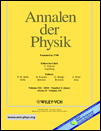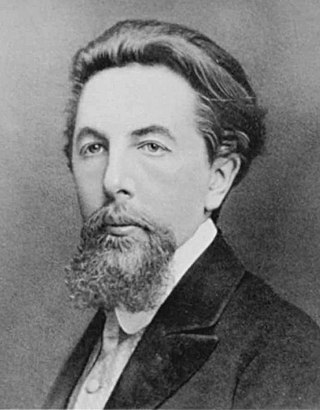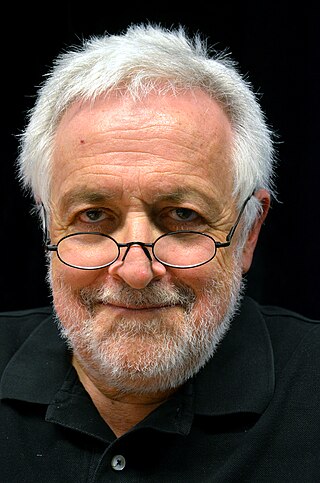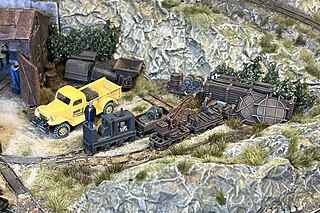Related Research Articles

The lux is the unit of illuminance, or luminous flux per unit area, in the International System of Units (SI). It is equal to one lumen per square metre. In photometry, this is used as a measure of the intensity, as perceived by the human eye, of light that hits or passes through a surface. It is analogous to the radiometric unit watt per square metre, but with the power at each wavelength weighted according to the luminosity function, a model of human visual brightness perception, standardized by the CIE and ISO. In English, "lux" is used as both the singular and plural form. The word is derived from the Latin word for "light", lux.

Annalen der Physik is one of the oldest scientific journals on physics; it has been published since 1799. The journal publishes original, peer-reviewed papers on experimental, theoretical, applied, and mathematical physics and related areas. The editor-in-chief is Stefan Hildebrandt. Prior to 2008, its ISO 4 abbreviation was Ann. Phys. (Leipzig), after 2008 it became Ann. Phys. (Berl.).

Mikhail Semyonovich Tsvet, also spelt Tsvett, Tswett, Tswet, Zwet, and Cvet was a Russian-Italian botanist who invented chromatography. His last name is Russian for "colour" and is also the root word of "flower."
The term degree is used in several scales of temperature, with the notable exception of kelvin, primary unit of temperature for engineering and the physical sciences. The degree symbol ° is usually used, followed by the initial letter of the unit; for example, "°C" for degree(Souvik) Celsius. A degree can be defined as a set change in temperature measured against a given scale; for example, one degree Celsius is one-hundredth of the temperature change between the point at which water starts to change state from solid to liquid state and the point at which it starts to change from its liquid to gaseous state.

Norbert Blüm was a German politician who served as a federal legislator from North Rhine-Westphalia, chairman of the CDU North Rhine-Westphalia (1987–1999), and Minister of Labour and Social Affairs.
A foot-lambert or footlambert is a unit of luminance in United States customary units and some other unit systems. A foot-lambert equals 1/π or 0.3183 candela per square foot, or 3.426 candela per square meter. The foot-lambert is named after Johann Heinrich Lambert (1728–1777), a Swiss-German mathematician, physicist and astronomer. It is rarely used by electrical and lighting engineers, who prefer the candela per square foot or candela per square meter units.

Henryk Marcin Broder, self-designation Henryk Modest Broder, is a Polish-born German journalist, author, and television personality. He was born into a Jewish family in Katowice, Poland.
Helvetisms are features distinctive of Swiss Standard German, that distinguish it from Standard German. The most frequent Helvetisms are in vocabulary and pronunciation, but there are also some distinctive features within syntax and orthography.
Swiss Standard German, or Swiss High German, referred to by the Swiss as Schriftdeutsch, or German: Hochdeutsch, is the written form of one of four official languages in Switzerland, besides French, Italian, and Romansh. It is a variety of Standard German, used in the German-speaking part of Switzerland and in Liechtenstein. It is mainly written, and rather less often spoken.

The kelvin, symbol K, is the base unit of measurement for temperature in the International System of Units (SI). The Kelvin scale is an absolute temperature scale that starts from 0 K, the coldest possible temperature, then rises by exactly 1 K for each 1 °C. The Kelvin scale was designed to be easily converted from the Celsius scale. Any temperature in degrees Celsius can be converted to kelvin by adding 273.15.
The High Com noise reduction system was developed by Telefunken, Germany, in the 1970s as a high quality high compression analogue compander for audio recordings.
Hebdo- (symbol H) is an obsolete decimal metric prefix equal to 107. It is derived from the Greek hebdοmos (Greek: ἕβδομος) meaning seventh.
Value criticism is a social theory which draws its foundation from the Marxian tradition and criticizes the contemporary mode of production. Value criticism was developed partly by critical readings of the traditions of the Frankfurt School and critical theory. Prominent adherents of value criticism include Robert Kurz, Moishe Postone and Jean-Marie Vincent.

The Wiesloch Feldbahn and Industrial Museum is a narrow-gauge railway and industrial heritage open-air museum established in 2001, at Wiesloch, Germany. The museum is centred around the former locomotive shed of the Tonwaren-Industrie Wiesloch (TIW) brickworks, and houses industrial equipment from large excavators to small machine tools, plus large and small locomotives.
The Verlag Harri Deutsch with headquarters in Frankfurt am Main, Germany, as well as in Zürich and Thun, Switzerland, was a German publishing house founded in 1961 and closed in 2013.

H0f gauge, occasional as H0i gauge designated, is a rail transport modelling scale representing Feldbahn-style 2 ft and 600 mm gauge railways using 1:87 HO scale running on Z gauge 6.5-millimetre (0.26 in) track. The Normen Europäischer Modellbahnen NEM 010 specification defines H0f for modelling gauges 400–650 millimetres (16–26 in), as part of the 1:87-scale family that includes narrow-gauge railway models using H0e gauge and metre-gauge railway models using H0m gauge.

Wolfgang Händler was a German mathematician, pioneering computer scientist and professor at Leibniz University Hannover and University of Erlangen–Nuremberg known for his work on automata theory, parallel computing, artificial intelligence, man-machine interfaces and computer graphics.
"Einer ist unser Leben" is a poem in five stanzas, written by Lothar Zenetti in 1973. It became a Christian hymn of the genre Neues Geistliches Lied (NGL) with a 1971 melody by Jean Liesse. The song is part of many hymnals, both Catholic and Protestant, and of songbooks, remaining popular in the 21st century.
The UC compander system is a noise reduction system for vinyl records, aiming at highest playback compatibility even without corresponding UC expander.

A Man and His Dog is a 1918 narrative by Thomas Mann. It describes the adventures of the narrator with his dog Bauschan (Bashan) in the nature surrounding the author's home in Munich. It was written in the twilight of World War I and portrays an idealised and timeless world.
References
- 1 2 Keplinger, Thomas (2021-03-29). "1939 bis 1945 – Im Keller glüht das Lumogen". Worte im Dunkel (in Austrian German). Vienna, Austria. Archived from the original on 2023-03-16. Retrieved 2023-03-16.
Skot und Nox […] Interessant ist in diesem Zusammenhang die Einführung neuer Messeinheiten. Die Voraussetzungen der Forschung beziehungsweise die Erfordernisse an die Leuchtfarben unterschieden sich so stark von allen bis dahin erforschten Gebieten, dass die Deutsche Lichttechnische Gesellschaft 1940 eigene Einheiten ins Leben rief: Die Dunkelleuchtdichte wurde in Skot und die Dunkelbeleuchtungsstärke in Nox gemessen. [A] Diese Einheiten grenzten an die bereits bestehenden Größen der Leuchtdichte und Beleuchtungsstärke an und dienten der zahlenmäßigen Erfassung geringster Lichtwerte. So entsprach etwa ein Nox 10−3 Lux.
- 1 2 3 4 5 Westphal, Wilhelm Heinrich (1952). "Nox, Dunkelleuchtdichte, Skot". Physikalisches Wörterbuch (in German) (1 ed.). Berlin / Göttingen / Heidelberg, Germany: Springer-Verlag OHG. pp. 125, 271, 389. doi:10.1007/978-3-662-12706-3. ISBN 978-3-662-12707-0 . Retrieved 2023-03-16. pp. 271, 389:
Dunkelleuchtdichte. […] Ist das Auge dunkeladaptiert, d.h. einer Leuchtdichte von weniger als 0,01 asb ausgesetzt, so gilt infolge des Purkinje-Phänomens eine von der spektralen Hellempfindlichkeitskurve abweichende, nach dem kurzwelligen Ende des Spektrums hin verschobene Empfindlichkeitskurve des Auges, die Stäbchenkurve des Dämmerungssehens. Unter Zugrundelegung dieser Empfindlichkeitskurve hat man 1940 in Deutschland die Dunkelleuchtdichte mit der Einheit Skot (sk) so festgesetzt, daß bei einem Licht der Farbtemperatur 2360 °K 1 sk = 10−3 asb gilt. 1948 ist von der Internationalen Beleuchtungskommission (IBK) die Bezugstemperatur auf 2046 °K, die Erstarrungstemperatur des Platins, festgesetzt worden. Die Bezeichnung Skot wurde von der IBK nicht übernommen, dafür soll "skotopisches Stilb" gesagt werden. Als höchstzulässiger Grenzwert für die Dunkelleuchtdichte ist in Deutschland 10 Skot festgesetzt worden, um eine Verwendung der Dunkelleuchtdichte im Gebiet des gemischten Zapfen- und Stäbchensehens zu vermeiden, da in diesem Bereich die photometrischen Maßgrößen wegen der allmählich gleitenden Augenempfindlichkeitskurve ihren Sinn verlieren. […] Skot, abgek[ürzt] sk, Einheit für die Dunkelleuchtdichte, welche für zahlenmäßige Angaben und zum Anschluß der Dunkelleuchtdichte an die normale Leuchtdichte 1940 von der Deutschen Lichttechnischen Gesellschaft geschaffen wurde. Für diesen Anschluß wurde die Strahlung des schwarzen Körpers bei T = 2360 °K, d.h. eine Strahlung der Farbtemperatur T1 = 2360 °K vereinbart. Eine Lichtquelle strahlt mit der Dunkelleuchtdichte 1 sk, wenn sie photometrisch gleich einer Strahlung der Farbtemperatur T2 = 2360 °K und der Leuchtdichte von 10−3 asb (Apostilb) ist. Bei der Farbtemperatur T1 = 2360 °K gilt also die Relation: 1 sk = 10−3 asb = 10−7/π sb. Ist die physikalische Strahlungsleistung Sλ einer beliebigen Lichtquelle als Funktion der Wellenlänge bekannt, so läßt sich zwischen den Zahlenwerten ihrer Leuchtdichte B gemessen in 10−3 asb, und ihrer Dunkelleuchtdichte B, gemessen in sk, die Verknüpfungsbeziehung {B}sk = (2,161 ± 0,001) {B}10−3 asb ∫ SλVλ,Wdλ / ∫ SλVλdλ angeben, wobei Vλ die relative spektrale Hellempfindlichkeit und Vλ,W die relative spektrale Dämmerungsempfindlichkeit nach Weaver [B] [C] bedeuten.
- 1 2 3 4 Grimsehl, Ernst [in German]; Schallreuter, Walter [in German] (1988) [1976]. "1. Licht: 1.4. Photometrie: 1.4.1. Grundbegriffe". In Haferkorn, Heinz (ed.). Lehrbuch der Physik: Optik (in German). Vol. 3 (19 ed.). Leipzig, Germany: BSB BG Teubner Verlagsgesellschaft. pp. 33–38 [37–38]. doi:10.1007/978-3-322-96431-1. ISBN 978-3-322-96432-8. Order No. 6666211, VLN 294-375/84/88, LSV 1164. Retrieved 2023-03-16. pp. 37–38:
Dunkelsehen […] Für das Dunkelsehen, bei dem nur die Stäbchen angeregt werden, definiert man die Dunkelleuchtdichte mit der Einheit Skot (sk) und die Dunkelbeleuchtungsstärke mit der Einheit Nox (nx). Die Umrechnungsfaktoren zwischen den Hell- und Dunkelgrößen hängen von der spektralen Zusammensetzung des Lichtes ab. Sie werden deshalb für die Farbtemperatur 2042 K (früher 2360 K) festgelegt. Bei dieser ist 1 sk = 10−3 asb und 1 nx = 10−3 lx.
- ↑ Dresler, Albert [in German] (1940) [February 1940, June 1940, July 1940]. Written at Berlin, Germany. "Messung und Berechnung von "Dunkelleuchtdichte" und "Dunkelbeleuchtungsstärke"". Das Licht (in German). Vol. 10, no. 2, 6, 7. Munich, Germany: Deutsche Lichttechnische Gesellschaft / Richard Pflaum Verlag GmbH & Co. KG. pp. 37, 103, 112, 118–120, 145–146. ISSN 0024-2861.
- ↑ Trendelenburg, Wilhelm; Monjé, Manfred [in German]; Schmidt, Ingeborg; Schütz, Erich [in German] (1961) [1943]. "II. Die Gesichtsempfindungen F. Das Nachtsehen und seine Beziehungen zum Tagessehen 5. Tageswerte der Spektralstrahlungen - Technische Lichtmessung b) Technische Lichtmessung". In Trendelenburg, Wilhelm; Schütz, Erich [in German] (eds.). Der Gesichtssinn - Grundzüge der Physiologischen Optik [The sense of sight - Principles of physiological optics]. Lehrbuch der Physiologie (in German) (2nd illustrated ed.). Springer-Verlag Berlin Heidelberg GmbH. p. 139–147 [144]. doi:10.1007/978-3-662-22085-6. ISBN 978-3-662-22086-3 . Retrieved 2023-03-25. p. 144:
[…] Die physiologischen (psychophysischen) Begriffe und Einheiten werden auf Grund der physikalisch meßbaren Strahlungsleistung auf den Gesichtssinn aufgestellt. Mit Ausnahme der Einheiten Skot und Nox beziehen sich alle auf das helladaptierte Auge. […]
(xii+440 pages) - 1 2 Stille, Ulrich [in German] (1965). "Fünfter Teil: Akustik und Phonometrie - optische Strahlung und Photometrie; Kapitel II: Größenarten der optischen Strahlung und Photometrie; 2. Spezielle Lichteinheiten / 3. Photometrisches Strahlungsäquivalent und (mechanisches) Lichtäquivalent". Messen und Rechnen in der Physik: Grundlagen der Grösseneinführung und Einheitenfestlegung (in German) (2nd improved and expanded ed.). Wiesbaden, Germany: Springer Fachmedien Wiesbaden GmbH. pp. 261–262 [262], 274–275 [275], 421. doi:10.1007/978-3-322-98458-6. ISBN 978-3-322-97920-9 . Retrieved 2023-03-20. (xii+471 pages)
- ↑ Lohse, Bernhard; Stille, Ulrich [in German] (January 1948) [1947-08-19]. Written at Braunschweig, Germany. Deutsche Physikalische Gesellschaft (ed.). "Einführung und Bestimmung des Lichtäquivalents". Zeitschrift für Physik (in German). 125 (1–3). Berlin / Göttingen / Heidelberg, Germany: Springer-Verlag: 133–158. Bibcode:1948ZPhy..125..133L. doi:10.1007/BF01337623. ISSN 0044-3328. S2CID 125512557 . Retrieved 2023-03-19.